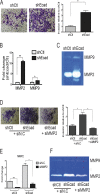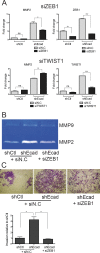Loss of E-cadherin activates EGFR-MEK/ERK signaling, which promotes invasion via the ZEB1/MMP2 axis in non-small cell lung cancer
- PMID: 24318272
- PMCID: PMC3926845
- DOI: 10.18632/oncotarget.1463
Loss of E-cadherin activates EGFR-MEK/ERK signaling, which promotes invasion via the ZEB1/MMP2 axis in non-small cell lung cancer
Abstract
Loss of E-cadherin, a hallmark of epithelial-mesenchymal transition (EMT), can significantly affect metastatic dissemination. However, the molecular mechanism of EMT-associated metastatic dissemination by loss of E-cadherin still remains unclear in non-small cell lung cancers (NSCLCs). In the present study, we show that the knockdown of E-cadherin was sufficient to convert A549 NSCLC cells into mesenchymal type with the concurrent up-regulation of typical EMT inducers such as ZEB1 and TWIST1. Interestingly, the EMT-induced cells by E-cadherin depletion facilitate invasion in a matrix metalloproteinase-2 (MMP2)-dependent manner with aberrant activation of EGFR signaling. We demonstrated that the elevated invasiveness was a result of the activated EGFR-MEK/ERK signaling, which in turn leads to ZEB1 dependent MMP2 induction. These results suggest that the EGFR-MEK/ERK/ZEB1/MMP2 axis is responsible for promoted invasion in EMT-induced NSCLCs. Consistently, ERK activation and loss of E-cadherin were both observed in the disseminating cancer cells at the invasive tumor fronts in NSCLS cancer tissues. Thereby, these data suggest that the EGFR-MEK/ERK signaling would be a promising molecular target to control aberrant MMP2 expression and consequent invasion in the EMT-induced NSCSLs.
Figures







References
-
- Thiery JP. Epithelial-mesenchymal transitions in tumour progression. Nat Rev Cancer. 2002;2(6):442–454. - PubMed
-
- Voulgari A, Pintzas A. Epithelial-mesenchymal transition in cancer metastasis: mechanisms, markers and strategies to overcome drug resistance in the clinic. Biochim Biophys Acta. 2009;1796(2):75–90. - PubMed
-
- Cavallaro U, Christofori G. Cell adhesion and signalling by cadherins and Ig-CAMs in cancer. Nat Rev Cancer. 2004;4(2):118–132. - PubMed
-
- Bremm A, Walch A, Fuchs M, Mages J, Duyster J, Keller G, Hermannstadter C, Becker KF, Rauser S, Langer R, von Weyhern CH, Hofler H, Luber B. Enhanced activation of epidermal growth factor receptor caused by tumor-derived E-cadherin mutations. Cancer Res. 2008;68(3):707–714. - PubMed
Publication types
MeSH terms
Substances
LinkOut - more resources
Full Text Sources
Other Literature Sources
Medical
Molecular Biology Databases
Research Materials
Miscellaneous

